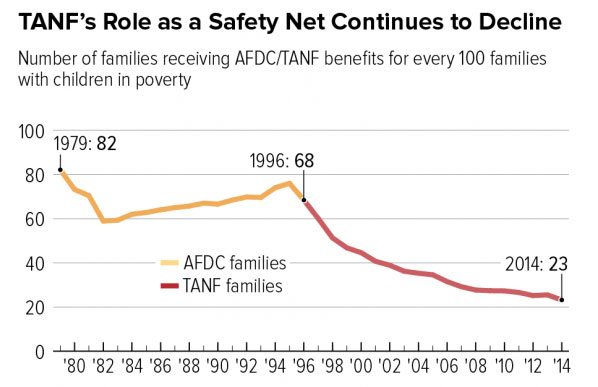Temporary Assistance for Needy Families (TANF) is a block grant to states that replaced the federal Aid to Families with Dependent Children (AFDC) program. This switchover happened in 1996 after the Congress passed reform legislation that promised to “end welfare as we know it.”
AFDC, as welfare had been known prior to TANF, had been a Federal entitlement program. By virtue of being an American citizen, a person in poverty could apply for and receive money from the Federal Government. (In contrast, Social Security and Medicare are not entitlement programs; only those who pay into those systems receive benefits.)
Welfare reform legislation changed this program from a Federal entitlement to block grants for individual states. When Congress passed the reform measure that created block grants for states, one of its most important requirements was for able-bodied adults to work or demonstrate they were trying to find work.
So that states would have maximum control over the block grants, they were allowed to create their own regulations as to who was entitled to cash assistance and who was not. Whatever state you were living in then created its own regulations. What were you entitled to if you were desperately poor, had children to feed and had no income? Nothing. You weren’t automatically “entitled” to anything. You received assistance from your individual state if you met their requirements, whatever they happened to be.
The reform legislation specified that a person could receive benefits for a maximum of 60 months during their lifetime, but a state is not required to pay benefits for that long. Is there a minimum number of months? No. It’s up to each state.
Arizona, a state that had provided benefits for a maximum of 24 months, recently passed legislation making 12 months the cut-off. According to the New York Times, Arizona’s new limit of 12 months of TANF assistance will remove 5,000 people from the welfare rolls by June, 2016.
“Policymakers created TANF 19 years ago with a two-pronged approach in mind — that our nation’s cash assistance system would be redesigned to create an expectation of work for able-bodied recipients and that states would maintain a safety net for parents who were unable to work due to a short-term crisis, a work-limiting disability, or a lack of available jobs,” according to the authors of a Center for Budget and Policy Priorities (CBPP) report titled “TANF Continues to Weaken as a Safety Net.”
How well has this worked? Statistically, it has been a great success in reducing welfare rolls by making such assistance difficult to get and by greatly reducing benefits.
The report, released on October 27, says that “…in a growing number of states, this cash safety net barely exists, leaving more families deeply poor and without the resources they need to meet their most basic needs through either employment or cash assistance.”
According to the report, “In 2014, for every 100 families in poverty, only 23 received cash benefits from TANF. This is down from the 68 families for every 100 in poverty that received cash assistance when TANF was first enacted in 1996. This ratio, which we call the TANF-to-poverty ratio (TPR), has declined nearly every year since 1996 and reached its lowest point in 2014.”
This does not mean that fewer people are poor. It means lots of people are poor and have exhausted their benefits.
Peter Germanis is a welfare expert whose opinions have carried weight among Republicans. He advised President Reagan on welfare issues and subsequently spent time with conservative think tanks in Washington, DC. In July of 2015, according to the New York Times, he issued a white paper on TANF and sent it to every member of Congress as well as other men and women of influence.
Writes Germanis, “This paper is an assessment of the Temporary Assistance for Needy Families (TANF) program… It challenges the widespread view that TANF is a successful program and a model for reforming other programs. Indeed, an objective analysis of TANF should lead anyone to conclude that it is an unprecedented failure.
“To the extent that anything I ever wrote contributed to the creation of TANF or any block grant, I am sorry,” he wrote. “As I hope to demonstrate in this paper, a block grant for a safety net program is bad public policy.”








